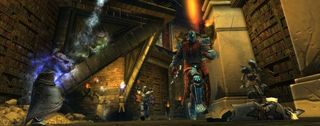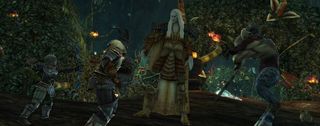
As extra-planar invasion-themed MMO Rift passes the one year mark, I caught up with Executive Producer Scott Hartsman to dive deep on one of Rift's more unique aspects: its dynamic world.
In our chat, Hartsman explains how Rift was initially conceived as a completely dynamic, unpredictable MMO, and why Trion had to step back from that ambition in the face of underwhelming playtests. What's happening underneath the hood when a rift opens, spilling forth a planar invasion force? How has Trion turned Rift into an "entertainment on demand" experience with its instant action feature, without detracting from the unpredictability and sense of discovery that Rift's dynamic content makes possible?
Even if you're not a Rift player, Hartsman gives provides a great perspective on the process behind building a different kind of MMO, and how that leads to unforeseen consequences like a cataclysmic battle in the least exciting place in Telara.
PC Gamer: How did your conception of Rift evolve over the course of development?
Scott Hartsman, Rift Executive Producer: We wanted things in the world that would naturally bring people together. Because we know that no matter how great the content we created, players are the stickiest thing in a game. So they started out as ways to get people engaged with challenging content and kind of knock them out of their comfort zone of playing traditional theme-park content.
One of the big turning points for us was, before launch, we did this big video called "Invasions" and it showed just this massive zone going crazy with fire invaders taking over an entire zone of the game. And we all looked at the video and went, "Okay, we need to make that happen in the game. If we can make that happen in the game, we will have something that nobody else has.
And the technology base that we're working with was built around the idea of dynamic content and events. This might be a little too in the weeds, but every creature that is walking around Rift, whether they're dynamic or static, every static NPC is actually an event that just happens to be "on" all the time. So every piece of content in our game, the engine views as an event. It's just a matter of: what is it doing when it's alive? And how does it show up? And how does it scale?
The biggest gaming news, reviews and hardware deals
Keep up to date with the most important stories and the best deals, as picked by the PC Gamer team.
PCG: Every creature is an event? Could you decode that a little?
Hartsman: Okay, so the traditional way of doing fantasy MMO content is you have a static spawner that spawns an NPC, and that NPC is also a static thing. Making them do anything interesting involves scripting, or special programming, or is some kind of challenge. Which is why you tend to not see this type of content in older generation games. It's just a big pain in the ass to make.
With our system, it was build from the ground-up with the concept of: what if everything could change all the time? What if everything was transitory? And actually, some of the first internal iterations of the content in this engine was 100 percent dynamic, 100 percent of the time. While it was fun in short spurts, it kind of didn't really have that feel of, "I am in this dependable MMO world, where I have these touch points of things I'm familiar with and things I've grown attached to." For us, it was more about realizing we needed to add in a static layer to actually give the game some context.
PCG: See, an ever-changing world sounds amazing to me. What was the frustration with that?
Hartsman: A lot of it came down to a lack of clarity. People need to feel like they have a place in the world in order to feel like it's a world they want to keep coming back to. And when everything is changing all the time, you don't have any anchor points. It's really difficult to communicate story and so on. And so it was more about making sure there was always this solid fictional grounding for what was going on the world, which is when the concept of Guardians and Defiants as the two major factions developed, and then the concept of the planar invaders followed in after that.

PCG: So how did you mix those elements together to solve those problems?
Hartsman: We started to think of them as two different layers, and that was really the key. There is a layer of what is perceived as static content in the world. The city of Meridia, the city of Sanctum, the exclamation mark farms for content and so on. And once people had that there, they felt that, "Okay, this is now a world that begins to make sense to me. I can begin to navigate this world."
And then when we began to create the dynamic layer on top of that. It was splitting it up into two different layers and having them interact interestingly with each other. You know, invaders will go after and set up footholds in static content layer elements. The dynamic AI has its own goals, it knows what it wants to do, it knows where it wants to go build up bases, and that layer doesn't really care whether it's fighting players or other NPCs in the world. Because players are entities that have faction relationships just like NPCs are, so that really, the dynamic layer is at war with everything.
PCG: So how wild do you let that get? Let's say the invaders come and the players, for whatever reason, are just like, "Screw it," How crazy does it get if you let that go unchecked?
Hartsman: If you were to take a server that was completely empty, for example, subtract away all the players and just let the dynamic layer do its own thing? It would take over most of the adventuring places in the world. And that was actually one of the big fun experiences we had when we first launched the game.
When we did the wipe just before the start, the servers had been up and running for a good 48 hours before we let players in there. And so the first thing the players had to do in Rift was retake Tellara zone by zone, because everything was taken over by the dynamic layer.
There's a scene in a zone called Silverwood that's called Marsh House and Marsh House is this otherwise very - there's really nothing special about it! It's just this corner where you end up in Silverwood at Level 8, and there was this incredible epic battle for Marsh House that literally raged on for like three or four hours before the players finally got it taken back, because the AI kept throwing enemies at them. So there were a couple hundred players and a couple hundred NPCs on the one server that I was sitting on, and yeah, the epic battle for Marsh House was like the last place in the universe we expected anything interesting to ever occur at all. Seriously! It's a hut at a fork in a road! It's completely not where we were expecting the big battle for Silverwood to take place. And once the players got that, they got their forward respawn point, they established a beachhead, and then they started to spread throughout the zone.
Most Popular







